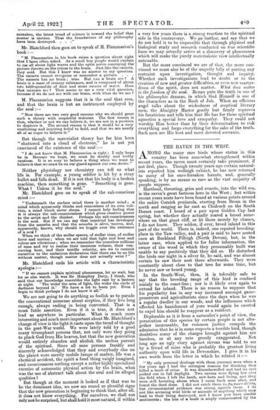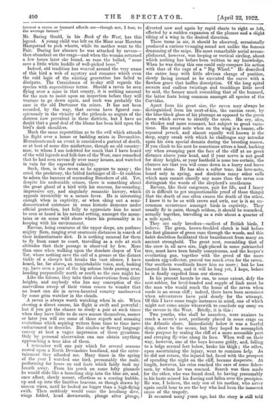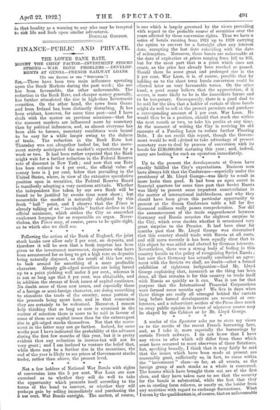THE RAVEN IN THE WEST. A MONG the many rare birds
whose status in this country has been somewhat strengthened within recent years, the raven must certainly take prominent, if not first, place. Though twenty years ago certain natural- ists reported him wellnigh extinct, he has now returned to many of his once-forsaken haunts, and, generally speaking, is by no means so rare as the vast majority of people suppose.
Hartland, thrusting, grim and remote, into the wild sea, is the raven's great fastness here in the West ; but within recent years nests have been found at various points around the entire Cornish peninsula, starting from Breen in the north and ranging as far east as Cludcock on the South Dorset coast. I heard of a pair upon Golden Cap last spring, but whether they actually reared a brood some- where on that giant cliff, or lit there merely by chance, I do not know. They seldon, if ever, breed Inland in this part of the world. There is, indeed, one reputed breeding- place in the Taw valley, and a pair is said to have nested once at Buckland Filleigh (North Devon), but, in the latter case, when applied to for fuller information, the owner of the wood in which they presumably built was unable to say positively that they did so. He disturbed the birds one night in a silver fir, ho said, and was almost certain he saw their nest there afterwards. They were constantly about close to that tree for some time, but he never saw or heard young.
In the South-West, then, it is tolerably safe to say that the breeding range of this bird is confined mainly to the coast-line ; nor is it likely over again to extend far inland. There is no reason to suppose that his popularity has in any way increased amongst game- preservers and agriculturists since the days when he was a regular dweller in our woods, and the influences which effected his banishment of yore would again be exerted to expel him should he reappear as a resident. Deplorable as it is from a naturalist's point of view, the persecution of this species by certain people is not alto- gether inexcusable, for common justice compels the admission that he is in some respects a terrible bird, though doubtless many of the charges brought against him are baseless, or at any rate grossly exaggerated. Not long ago an ugly story against ravens was told to me by a friend of mine who is probably the greatest living authority upon wild life in Devonshire. I give it in his own words from the letter in which he related it :— " My only personal dealings with them (ravens) wore when a few years ago I had the strongest reasons for thinking they killed a lamb of mine. It was disembowelled and had its eyes picked out in full daylight. Two ravens were flying low over the field when I left the lamb, new-born and living, and they were still hovering about when I came back soon after, and found the deed done. I did not catch thorn inficsgrarve dela°, but circumstantial evidence was strong against them. I do not like accusing wild birds or animals of anything which may lead to their being destroyed, and I know you have similar sentiments the loss of a lamb is amply compensated by the interest a raven or buzzard affords me—though not, I fear, to the average farmer."
Mr. Baring Gould, in his Book of the West, has this legend. A young child was left on the Moor near Moreton Hampstead to pick whorts, while its mother went to the Fair. During her absence he was attacked by ravens— then abundant on the crags—and when the woman returned a few hours later she found, so runs the ballad, " none save a little white huddle of well-picked bone."
Indeed, old tradition has weaved around the very name of this bird a web of mystery and romance which even the cold logic of the existing generation has failed to dissipate. The Cornishman of to-day still regards the species with superstitious terror. Should a raven be seen flying over a mine in that county, it is nothing unusual for the men to insist upon an inspection before they will venture to go down again, and such was probably the case in the old Dartmoor tin mines. It has not been recorded, by the way, that ravens have figured con- spicuously in the vicinity of the pitheads as augurs of the distress now prevalent in these districts, but I have no doubt that a good deal of the blame has been laid upon the bird's dark shoulders.
Much the same superstition as to the evil which attends his flight over a house or building exists in Devonshire. Hereabouts such an event is considered a portent of death, or at best of some dire misfortune, though an old country- man, to whom I am indebted for much that I have heard of the wild legends and folk-lore of the West, once remarked that he had seen ravens fly over many houses, and watched in vain for the expected calamity Such, then, is the raven as he appears to many ; the cruel, the predatory, the fabled harbinger of ill—fit emblem to adorn the banners of marauding Bersekers of old. Yet, despite his undeniable crimes, there is something about the great ghoul of a bird with his raucous, far-sounding, impressive cry, and singularly romantic history, which appeals irresistibly to a. nature lover. He is interesting enough when in captivity, or when eking out a semi- domesticated existence in some historic demesne under official protection, but fully to appreciate him ho must be seen or heard in his natural setting, amongst the moun- tains or on some wild shore where his personality is in keeping with his environment. Ravens, being creatures of the upper deeps, are perforce mighty fliers, ranging over enormous distances in search of their indiscriminate diet. It is nothing unusual for them to fly from coast to coast, travelling as a rule at such altitudes that their passage is observed by few. More than once when walking upon the desolate slopes of Yes Tor, where nothing save the call of a grouse or the distant tinkle of a sheep's bell breaks the vast silence, I have heard, far, far above, an unmistakable voice, and, looking up, have seen a pair of the big solemn birds passing over, heading purposefully north or south as the case might be. Like the falcons, they take their observations from dizzy heights, and anybody who has any conception of the marvellous sweep of their vision ceases to wonder that no beast can die in raven-haunted country unobserved by some grim watcher in the clouds.
A raven is always worth watching when in air. When steering a direct course, his flight is swift and powerful ; but if you get the chance to study a pair at such times when they have little to do save amuse themselves, sooner or later you will see some of those superb and amazing evolutions which aspiring writers from time to time have endeavoured to describe. But similes or flowery language convey at best a vague impression of these gyrations. Only by personal observation can one obtain anything approaching a true idea of them. I remember well one pair which for several seasons nested upon a North Devonshire headland, and the enter- tainment they afforded me. Many times in the spring of the year I watched one bird, presumably the male, performing for hours on end feats which fairly took my breath away. From his perch on some lofty pinnacle he would slide like a launching ship into the blue air, and, once afloat, slowly mount, effortless as a soaring bubble, up and up into the limitless heavens, as though drawn by unseen wires, until he looked no bigger than a high-flying swift. Then suddenly would come the headlong dive, wings folded, head downwards, plunge after plunge, diverted now and again by rapid slants to right or left, effected by a sudden expansion of the plumes and a slight tilting of a wing in the desired direction.
These turns in air, it should be observed, occasionally produced a curious twanging sound not unlike the famous drumming of the snipe. His most remarkable aerial accom- plishment, however, was looping or vertical circling, about which nothing has before been written to my knowledge. When he was doing this one could only compare his action with that of the cage of a " Big Wheel." He described the entire loop with little obvious change of position, slowly facing around as he executed the curve with a flawless grace that baffles description. Of the long spiral ascents and endless twistings and tuinblings little need be said, the former much resembling that of the buzzard, the latter feats being common amongst all species of the Corvidae.
Apart from his great size, the raven may always be distinguished from his next-of-kin, the carrion crow, by the blue-black gloss of his plumage as opposed to the green sheen which serves to identify the crow. His cry, also, is thicker and more resonant, but subject to great varia- tions. His usual note when on the wing is a hoarse, oft- repeated prruck, and almost equally well known is the deep, angry croak with which he challenges any intruder upon his own special domain during the breeding season. If you climb to his nest he sometimes utters a loud, barking cry when swooping past the face of the cliff at no great distance above your head, and if your nerve is not good for dizzy heights, or your foothold is none too certain, the chances are that you will come down in a hurry and leave his nest alone. He has also a softer tone, his love-note, heard only in spring, and doubtless many other calls which man cannot classify any more than the raven can distinguish the words of the shepherd's anathemas.
Ravens, like their congeners, pair for life, and I fancy (it is difficult to get unquestionable proof of these things) that the death of one often causes the death of the other. I know it to be so with crows and owls, nor is it an un- common occurrence amongst birds in captivity. They usually fly in pairs, though seldom, it should be remarked, actually together, travelling as a rule about a- quarter of a mile apart. They are early breeders—earliest of British birds, I believe. The green, brown-freckled clutch is laid before the first glimmer of green runs through the woods, and this habit doubtless facilitated their banishment from many an ancient stronghold. The great nest, resembling that of the crow in all save size, high-placed in some patriarchal tree, must have been fatally conspicuous, and the keeper's everlasting gun, together with the greed of the more modern egg-collector, proved too much even for the raven. Our southern woodlands know him no more ; but he has learned his lesson, and it will be long yet, I hope, before he is finally expelled from our shores.
In his present haunts he can, to some extent, defy the nest-robber, for level-headed and supple of limb must be the man who would reach the home of the raven when made in an ocean cliff ; indeed, there have been occasions when adventurers have paid dearly for the attempt. Of this I have some tragic instances in mind, one of which might not come amiss wherewith to conclude my essay on the ravens in the West. Briefly, it is this : Two youths, who shall be nameless, were anxious to reach a raven's nest, perilously placed in some crags on the Atlantic shore. Immediately below it was a fearful drop, sheer to the ocean, but they hoped to accomplish their purpose by scaling the cliff at a more accessible part and creeping fly-wise along its face. When well on their way, however, one of the boys became giddy, and, falling to a ledge several feet below, broke his thigh ; the other, upon ascertaining the injury, went to summon help. As he did not return, the injured lad, faced with the prospect of spending the night on the cliff, became desperate. At length, however, his cries reached the ears of some fisher- men, by whom he was rescued. Search was then made for the other, who was found dead, he having presumably in his haste missed his footing and fallen over the precipice. He was, I believe, the only son of his mother, who never• again could bear to see the boy who had been the innocent cause of the tragedy. It occurred many years ago, but the story is still told in that locality as a warning to any who may be tempted to risk life and limb upon similar adventures. DOUGLAS CORDON.




































 Previous page
Previous page